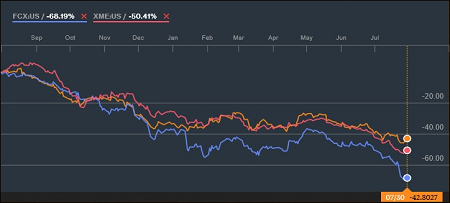
SPDR S&P Metals & Mining Exchange Traded Fund (Red), Freeport-McMoRan (Blue), and BHP Billiton (Orange) Charts for Past Year
By Pam Martens and Russ Martens: July 31, 2015
The commodities slump has accelerated this past month with gold now trading at five-year lows and the U.S. crude benchmark, West Texas Intermediate (WTI), down 19 percent in just the past month, 49 percent on the year, and 57 percent in the past two years. In early morning trade, WTI is at $47.82 versus $110 two years ago.
Minutes of the Federal Reserve’s Open Market Committee meeting on December 16 and 17 reveal that the Fed was expecting an upturn in oil prices this year, writing: “…inflation was projected to reach the Committee’s objective over time, with longer-run inflation expectations assumed to remain stable, prices of energy and non-oil imports forecast to begin rising next year, and slack in labor and product markets anticipated to diminish slowly.”
CNN Money is reporting this morning that major iron ore or metals exporting countries like Peru (copper), Chile (copper), South Africa (iron ore and gold), Australia (iron ore and gold), Brazil (iron ore), Zambia (copper), and Democratic Republic of the Congo (metals and crude oil) are experiencing a serious economic impact from the plunge in commodity prices over the past year.
There are three major culprits behind the global glut and commensurate decline in the price of industrial commodities. The growing gap in income and wealth equality worldwide is aggravating the consumers’ inability to boost economic activity; China is the world’s largest importer of industrial commodities and it’s experiencing both an economic slowdown and a loss of investor confidence as a result of wild gyrations in its stock market and unprecedented government props to prevent a collapse; and, finally, Fed Chair Janet Yellen’s incessant chatter about an upcoming hike in U.S. interest rates has elevated the U.S. Dollar, putting more downward pressure on commodity prices.
Most industrial commodities are priced in U.S. Dollars, making them more expensive as foreign currencies decline in value. According to the Bloomberg Dollar Spot Index, the U.S. Dollar is now trading at its highest level since 2004 versus 10 other major currencies.
The rout in foreign currencies is now forcing some countries to raise interest rates to defend their currencies at one of the most inopportune times in terms of economic weakness. Bloomberg Business is out with the following disturbing news this morning: “All of the 24 most-widely-traded emerging-market currencies tracked by Bloomberg have weakened over the past month except for the Hungarian forint. An index of their exchange rates has dropped 8 percent this year to the lowest on record in data going back to 1993. The current pace of declines would make this the worst year since 2008.”
Growing comparisons to the conditions leading to the financial crisis in 2008 are causing investors to rethink their exposure to roller coaster markets and the potential for liquidity air pockets. That lack of confidence is being exacerbated by a growing feeling that the Fed is either living in a fantasyland of economic optimism or simply talking its book to support the U.S. Dollar and prevent a capital flight.
One thing is for sure, as the above chart of metals and mining stocks shows, Ms. Yellen is presiding over a lot of pain in a broad number of arenas.

